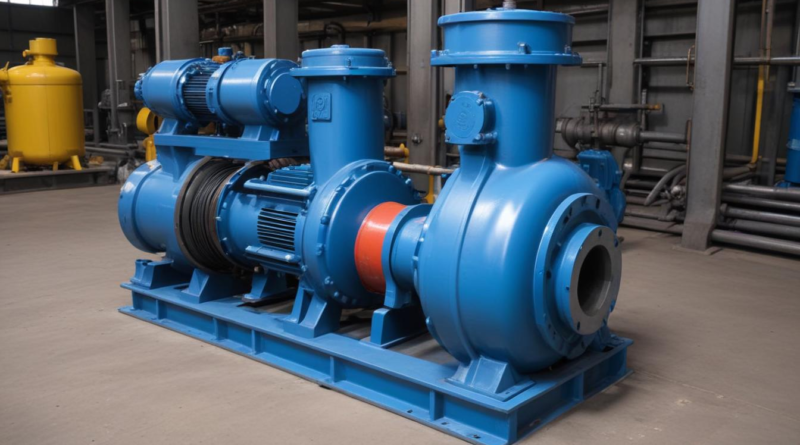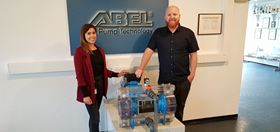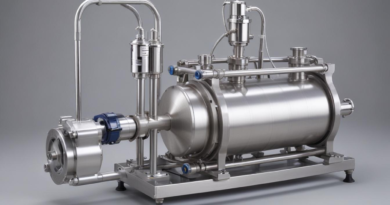how to ensure pump reliability
Regular maintenance schedules are essential for ensuring pump reliability and minimizing downtime. Implementing a structured maintenance regimen that aligns with industry best practices involves several key components:
- Routine Inspections: Conduct regular checks to identify potential issues early. These inspections should include:
- Checking for leaks and unusual noises
- Inspecting seals, gaskets, and connections
- Assessing vibration levels and alignment
- Lubrication Procedures: Proper lubrication reduces friction and wear on moving parts. A maintenance schedule should specify:
- Type of lubricant to be used
- Frequency of lubrication
- Monitoring and adjusting lubricant levels
- Wear Part Replacement: Proactively replacing components that are subject to wear can prevent unexpected failures. This includes:
- Bearings
- Seals and gaskets
- Impellers and casings
- Cleaning Protocols: Maintaining cleanliness around the pump ensures optimal performance and longevity. Tasks involve:
- Removing debris from suction lines
- Cleaning external surfaces and cooling areas
- Ensuring proper drainage to avoid water accumulation
- Documentation and Record-Keeping: Keeping detailed records of all maintenance activities facilitates trend analysis and future planning. Records should include:
- Date and type of maintenance performed
- Parts replaced or serviced
- Observations and recommendations
A sample maintenance schedule might look like the following:
| Task | Frequency | Description |
|---|---|---|
| Visual Inspection | Weekly | Check for leaks, unusual noises, and vibrations |
| Lubrication | Monthly | Apply lubricant to bearings and moving parts |
| Performance Testing | Quarterly | Assess pump efficiency and output levels |
| Component Replacement | Annually | Replace wear parts according to manufacturer guidelines |
Adhering to a comprehensive maintenance schedule not only enhances pump reliability but also extends the operational lifespan of the equipment, ensuring consistent performance and reducing the likelihood of costly repairs or replacements.
condition monitoring techniques
Implementing effective condition monitoring is pivotal for maintaining pump reliability and ensuring uninterrupted operations. These techniques enable the early detection of potential issues, allowing for timely interventions that can prevent costly failures and extend the lifespan of the equipment. Key condition monitoring methods include:
- Vibration Analysis: By measuring and analyzing the vibrations of a pump, this technique helps identify imbalances, misalignments, bearing faults, and other mechanical issues. Regular vibration monitoring can reveal trends that indicate deteriorating conditions before they lead to significant failures.
- Thermography: Utilizing infrared cameras, thermography detects abnormal temperature patterns in pump components. Overheating can signify problems such as electrical issues, lubrication failures, or excessive friction, allowing maintenance teams to address these concerns proactively.
- Acoustic Emission Monitoring: This method involves listening to the sounds produced by a pump during operation. Unusual noises can indicate issues like cavitation, leaks, or component wear. Acoustic monitoring is especially useful for detecting problems that are not easily visible through other techniques.
- Oil Analysis: Regular sampling and analysis of pump lubricants can reveal contaminants, wear particles, and changes in lubricant properties. This information is critical for assessing the internal condition of the pump and determining when maintenance or lubricant replacement is necessary.
- Flow and Pressure Monitoring: Continuously tracking the flow rate and pressure of the pump can help identify deviations from normal operating conditions. Fluctuations in these parameters may indicate blockages, leaks, or inefficiencies that need to be addressed to maintain optimal performance.
A structured approach to condition monitoring can be outlined as follows:
| Monitoring Technique | Key Indicators | Benefits |
|---|---|---|
| Vibration Analysis | Imbalance, Misalignment, Bearing Faults | Early detection of mechanical issues, reduces unexpected downtime |
| Thermography | Overheating, Electrical Problems | Prevents thermal failures, enhances safety |
| Acoustic Emission | Cavitation, Leaks, Wear | Non-invasive detection of hidden issues |
| Oil Analysis | Contaminants, Wear Particles | Monitors internal pump condition, informs maintenance needs |
| Flow and Pressure | Flow Rate Deviations, Pressure Drops | Ensures pump operates within desired parameters, detects operational issues |
Adopting a combination of these condition monitoring techniques as part of best practices enables maintenance teams to maintain high levels of pump reliability. Integrating these methods with a comprehensive maintenance schedule ensures that any anomalies are promptly addressed, thereby minimizing the risk of unexpected downtime and enhancing the overall efficiency of pumping systems.
proper installation practices
Ensuring that pumps are installed correctly is fundamental to achieving optimal performance and long-term reliability. Adhering to established installation protocols minimizes the risk of operational issues and enhances the overall effectiveness of the pumping system. Key aspects of proper installation include:
- Site Preparation: Adequate preparation of the installation site is crucial. This involves:
- Ensuring a stable and level foundation to prevent vibrations and misalignments
- Verifying that the environment meets the pump’s operational requirements, including temperature and humidity controls
- Providing sufficient clearance for maintenance access and future inspections
- Alignment and Mounting: Proper alignment of the pump and its driver (e.g., motor or engine) is essential to reduce wear and tear. This includes:
- Using precision alignment tools to ensure the pump and driver shafts are perfectly aligned
- Securing the pump and driver firmly to the foundation to prevent movement during operation
- Implementing flexible mounts or vibration isolators to absorb shocks and minimize vibrations
- Pipeline Connections: Correctly connecting the inlet and outlet pipelines ensures efficient flow and prevents leaks. Steps involve:
- Using appropriate pipe materials and sizes as specified by the manufacturer
- Ensuring smooth transitions and minimizing bends or fittings that could cause flow restrictions
- Applying proper sealing techniques, such as using high-quality gaskets and thread sealants
- Electrical Installation: For electrically driven pumps, adhering to electrical installation standards is vital. This includes:
- Ensuring all electrical connections meet local codes and safety standards
- Installing appropriate protection devices, such as circuit breakers and surge protectors
- Verifying that the power supply matches the pump’s voltage and frequency requirements
- Initial Testing and Calibration: Before full-scale operation, conducting thorough testing ensures that the pump functions correctly. This process includes:
- Performing dry runs to check for any immediate issues with installation
- Calibrating control systems to maintain desired flow rates and pressures
- Monitoring initial performance metrics to establish baseline data for future comparisons
A checklist for proper installation might include the following steps:
| Step | Description | Responsible Party |
|---|---|---|
| 1. Site Inspection | Verify site conditions and readiness for installation | Project Manager |
| 2. Foundation Setup | Ensure a stable and level foundation is in place | Construction Team |
| 3. Alignment | Accurate alignment of pump and driver shafts | Installation Engineers |
| 4. Pipeline Installation | Connect inlet and outlet pipelines correctly | Plumbing Specialists |
| 5. Electrical Setup | Complete all necessary electrical connections and protections | Electricians |
| 6. Testing | Conduct initial tests and calibrate systems | Quality Assurance Team |
Adhering to these installation best practices not only ensures immediate operational success but also lays the foundation for sustained pump reliability. Proper installation minimizes the likelihood of early failures, reduces maintenance needs, and enhances the overall efficiency of the pumping system.
selecting quality components
 Selecting the right components is fundamental to achieving and maintaining high levels of pump reliability. Utilizing quality parts not only enhances performance but also reduces the frequency of maintenance and the likelihood of unexpected failures. Key considerations in choosing quality components include:
Selecting the right components is fundamental to achieving and maintaining high levels of pump reliability. Utilizing quality parts not only enhances performance but also reduces the frequency of maintenance and the likelihood of unexpected failures. Key considerations in choosing quality components include:
- Material Compatibility: Ensuring that all components are made from materials compatible with the fluid being pumped is essential. Factors to consider include:
- Chemical resistance to prevent corrosion and degradation
- Mechanical properties to withstand pressure and temperature variations
- Durability to extend the lifespan of the pump
- Manufacturer Reputation: Selecting components from reputable manufacturers guarantees adherence to industry standards and reliability. Important aspects are:
- Proven track record and customer reviews
- Compliance with relevant certifications and standards
- Availability of warranties and support services
- Design Specifications: Components must meet the specific design requirements of the pump system to ensure optimal performance. This includes:
- Proper sizing to match flow and pressure needs
- Compatibility with existing pump models and configurations
- Advanced features such as enhanced sealing or improved efficiency
- Quality Control: Rigorous quality control processes during manufacturing ensure that components perform reliably under operating conditions. Key elements include:
- Consistent manufacturing processes to maintain part uniformity
- Thorough testing for defects and performance standards
- Detailed quality assurance documentation
- Supplier Reliability: Partnering with dependable suppliers ensures timely delivery and availability of replacement parts. Factors to evaluate are:
- Supply chain stability to prevent delays
- Comprehensive inventory management for quick access to parts
- Strong customer service and technical support
A structured approach to selecting quality components can be illustrated in the following table:
| Criteria | Description | Considerations |
|---|---|---|
| Material Compatibility | Ensures components resist corrosion and wear | Chemical properties, temperature tolerance, mechanical strength |
| Manufacturer Reputation | Guarantees adherence to standards and reliability | Industry certifications, customer feedback, warranty terms |
| Design Specifications | Matches pump system requirements for optimal performance | Proper sizing, compatibility, advanced features |
| Quality Control | Maintains component uniformity and performance standards | Manufacturing consistency, defect testing, documentation |
| Supplier Reliability | Ensures availability and timely delivery of parts | Supply chain stability, inventory management, customer support |
Implementing best practices in component selection involves conducting thorough assessments and due diligence. This includes verifying material specifications, requesting samples for testing, and evaluating supplier credentials. Additionally, establishing strong relationships with suppliers can lead to better pricing, preferential treatment for critical parts, and access to the latest technological advancements.
Investing in high-quality components may involve higher upfront costs, but the long-term benefits in terms of reduced maintenance requirements, fewer breakdowns, and extended pump lifespan provide significant value. By prioritizing quality in every aspect of component selection, organizations can ensure sustained pump reliability and achieve greater operational efficiency.
training and expertise
Ensuring that personnel possess the necessary training and expertise is fundamental to achieving optimal pump reliability. Skilled and knowledgeable teams are better equipped to perform maintenance, troubleshoot issues, and implement best practices, thereby minimizing downtime and extending the lifespan of pumping systems. Key elements in developing and maintaining a proficient workforce include:
- Comprehensive Training Programs: Structured training programs provide employees with the essential knowledge and skills required to operate and maintain pumps effectively. These programs should cover:
- Basic pump operation principles
- Identification and understanding of pump components
- Standard maintenance procedures and schedules
- Troubleshooting common pump issues
- Safety protocols and best practices
- Certification and Accreditation: Obtaining relevant certifications ensures that personnel meet industry standards and possess validated expertise. Important certifications include:
- Certified Maintenance & Reliability Professional (CMRP)
- Pump Systems Matter (PSM) certification
- Manufacturer-specific training and certification programs
- OSHA safety certifications
- Hands-On Training and Apprenticeships: Practical experience is invaluable for mastering pump maintenance and repair. Initiatives should include:
- Apprenticeship programs combining on-the-job training with classroom instruction
- Simulation-based training for handling complex situations
- Mentorship programs pairing less experienced workers with seasoned experts
- Continuous Education and Skill Development: The dynamic nature of pump technology necessitates ongoing education to keep skills current. Strategies include:
- Regular workshops and seminars on the latest pump technologies and trends
- Access to online courses and e-learning platforms
- Participation in industry conferences and trade shows
- Subscription to industry journals and publications
- Knowledge Sharing and Documentation: Encouraging the dissemination of knowledge within the organization enhances collective expertise. Practices involve:
- Creating and maintaining detailed maintenance manuals and troubleshooting guides
- Hosting regular team meetings to discuss challenges and solutions
- Implementing a centralized knowledge base for easy access to information
- Encouraging cross-training among different departments and roles
- Performance Evaluation and Feedback: Regular assessment of employee performance ensures that training programs are effective and identifies areas for improvement. Methods include:
- Conducting periodic performance reviews
- Soliciting feedback from employees on training effectiveness
- Implementing metrics to measure the impact of training on pump reliability
- Adjusting training programs based on evaluation outcomes
A structured approach to training and expertise development can be outlined in the following table:
| Training Element | Description | Benefits |
|---|---|---|
| Comprehensive Training Programs | Provide fundamental and advanced knowledge on pump operations and maintenance | Enhances operational efficiency, reduces errors, and improves pump reliability |
| Certification and Accreditation | Validates the expertise and adherence to industry standards | Ensures high-quality maintenance practices and builds trust with stakeholders |
| Hands-On Training and Apprenticeships | Offers practical experience and real-world problem-solving skills | Prepares employees to handle complex maintenance and troubleshooting tasks effectively |
| Continuous Education and Skill Development | Keeps personnel updated with the latest technologies and methodologies | Maintains a competitive edge and adapts to evolving industry demands |
| Knowledge Sharing and Documentation | Facilitates the exchange of information and best practices within the organization | Promotes a culture of continuous improvement and collective problem-solving |
| Performance Evaluation and Feedback | Assesses the effectiveness of training programs and identifies improvement areas | Ensures training initiatives are aligned with organizational goals and pump reliability standards |
Investing in the training and development of personnel not only fosters a skilled workforce but also instills a culture of excellence and accountability. Well-trained employees are more likely to adhere to best practices, perform preventive maintenance diligently, and respond swiftly to operational challenges. This proactive approach significantly contributes to the sustained reliability of pumps, ensuring that systems operate smoothly and efficiently over the long term.



